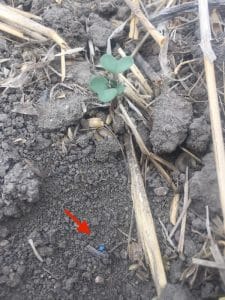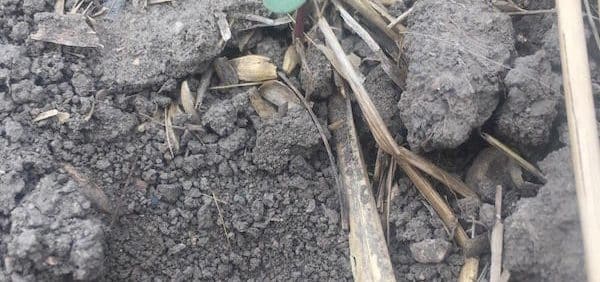Start scouting around the time when emergence should occur. Normally by late May, warm soils, decent moisture and 1” seeding depth should produce emergence be about a week after seeding. However, dry conditions can delay emergence.

Scouting step 1. Count plants and relate that to seeding rate. Use the Canola Calculator plant survival calculator. Seedling diseases, flea beetles, frost and other factors can influence seed survival, and unless scouting and counts are done repeatedly through the first few weeks after seeding, these influences may be missed and the seeding tool or other seedbed conditions may be unfairly blamed. How to use a hoop to do plant counts. NOTE: When doing plant counts, be sure to subtract volunteers. Plants growing outside the seed row are likely volunteers. Very early looking plants are also likely volunteers. You can check by looking for the blue seed coat around the seed.
Scouting step 2. Assess seeder performance. Rows with poor emergence beside rows with good emergence would suggest a drill problem — maybe due to varying opener depth or plugged lines. READ MORE
What else to look for:
Insect damage. Flea beetles are usually the most serious insect pest this time of year. Examine newer leaves for recent damage and look for stem feeding. Note that canola seed treatments require a bit of feeding to stop flea beetles, so older leaves may show some damage for this reason while newer leaves may be undamaged – indicating the crop is growing ahead of the feeding and a foliar insecticide application is not likely needed. READ MORE on flea beetles. Cutworms can also remove young canola plants. Look for bare patches and dig around the perimeter of the patch to look for cutworms just below the soil surface. READ MORE on cutworms.
Seedling diseases. Seedling diseases caused by fusarium and pythium species tend to be worse in cool, wet conditions while rhizoctonia tends to be worse when canola emergence is delayed due to cool, dry conditions. The broad spectrum fungicide seed treatments used to treat certified seed typically provide good protection from these seedling diseases. The tell-tale sign of disease is patchy emergence up to the four-leaf stage of the crop. Seeds or seedlings may decay prior to emergence or the seedlings may emerge and appear normal, then stagnate at the two- to four-leaf stages. These plants will often die. READ MORE
Early blackleg. Blackleg also effects young canola plants when temperatures have been warm and the soil is moist. The earlier the infection, the higher the yield loss from blackleg. Scout cotyledons looking for greyish-white lesions speckled with black pycnidia. Severe infections will cause girdling of the stem and premature death of the plant. Learn how to identify between seedling diseases and blackleg to better plan some different approaches to manage blackleg in the future years. READ MORE
Weeds. Early-season weed competition is the most costly to yield. If fields did not get a pre-seed burnoff, expect to see some weed competition and spray them early in the window. Earliest spray opportunity varies by HT system.
Herbicide damage. Carryover of residual products from last year can be a concern in dry conditions. Mistakes with pre-seed burnoff products can also cause damage.
Fertilizer damage. This can be difficult to diagnose but higher rates of seed-placed fertilizer in dry soils and with low seed-bed utilization (narrow openers and wider rows) can cause seed and seedling mortality. Seeds that are dried up and powder-like inside may be fertilizer damaged.
Frost. Any amount of frost can start taking out plants. One factor is the daily highs leading up to the frost. If days had been cool (10°C), canola plants may be more acclimatized to a heavier frost. If days had been warm (20°C), even a light frost can cause some seedling death. READ MOREWind. High winds can blow seeds and seedlings right out of the ground, especially if topsoil is dry. Soil-particles blown by the wind can also “sand blast” seedlings. READ MORE
Residue. Thick or uneven residue can have implications for frost damage and reduced seeder performance. With regard to frost, residue means the soil doesn’t warm as much during the day and doesn’t release its stored heat as quickly during the night. Seedlings growing up through heavy residue can therefore be more susceptible to frost. Another factor is that seedlings growing up through residue tend to have longer more exposed hypocotyls.
Further reading:

